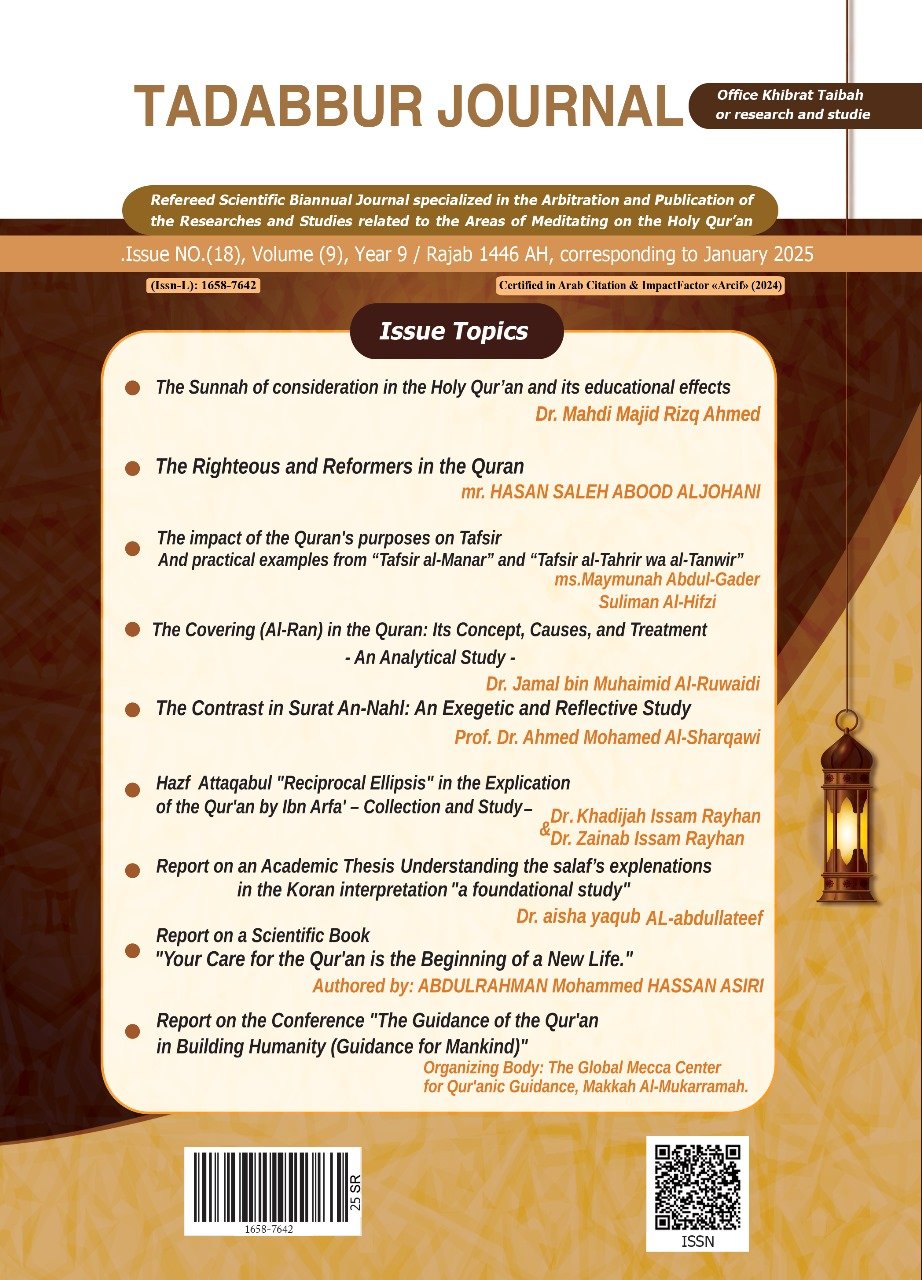The impact of the Quran's purposes on TafsirAnd practical examples from “Tafsir al-Manar” and “Tafsir al-Tahrir wa al-Tanwir”
Main Article Content
Abstract
Research Topic: The impact of the Quran's purposes on Tafsir and practical examples from "Tafsir al-Manar" and "Tafsir al-Tahrir wa al-Tanwir".
Research Boundaries: "Tafsir al-Manar" for Mohammad Rasheed Reda and "Tafsir al-Tahrir wa al-Tanwir" for Ibn Ashour.
Research Objectives: To explain the concept of Maqasid-based Tafsir (explication)، its relationship with other types of Tafsir، and how explicators use the purposes of the Quran. Additionally، to clarify the impact of the Quran's purposes on explication، their role in understanding، contemplating، and deriving meanings from the Quran، and to extract practical examples of this from "Tafsir al-Manar" and "Tafsir al-Tahrir wa al-Tanwir".
Approach: The research employed both the inductive and deductive methods.
The most important research results and recommendations: Among the most significant findings were that understanding the purposes (Maqasid) of the Quran is indispensable for any type of Tafsir، especially thematic Tafsir. Key impacts of the Quran's purposes on explication include clarifying the meaning of verses، identifying the intended audience، understanding the implications of the restrictions mentioned in the Quranic discourse، removing the contradictions of the meanings that come to mind in the texts، weighing the opinions of explicators، and guiding the explicator in the correct direction.
Conclusion: In “Tafsir al-Manar”، the author placed significant emphasis on incorporating the Quran's purposes (Maqasid) into the explication، which is evident in most instances. This includes clarifying the moral lessons of Quranic stories، explaining the connection between verses، and preferring certain explications of scholars based on the purposes. However، at times، the author might overly emphasize these purposes، leading to explications that contradict the apparent meaning of the text and the views of the majority of explicators. This misguided approach may be a result of the general methodology of the rationalist school. Similarly، Ibn Ashur، in his “Tafsir al-Tahrir wa al-Tanwir”، paid great attention to the purposes of the Quran، which is clearly reflected in most instances. He prioritized the purposes، expanded the explanation of verses for clarity، rejected certain juristic opinions based on these purposes، opted for metaphorical over literal explications in some cases، and explained the relevance of a verse to its context based on the purposes. Hence، he is considered one of the most prominent explicators in this field.
Downloads
Article Details
Conference Proceedings Volume
Section

This work is licensed under a Creative Commons Attribution-NonCommercial 4.0 International License.
Indicating to the intellectual property, copyrights, and open access right:
According to the Budapest Initiative 2002; tadabbur Journal, which is issued by Khibrat Taibah For Research and Studies in Medina, provides free open access to its publications, and applies the Creative Commons license:
Attribution- Non-Commercial 4.0 International (CC BY-NC 4.0) for the works it publishes from peer-reviewed scientific research and reports, which are freely available on the Internet, and which allows any user to read, download, copy, and distribute (Convert), print, search, or create links to the full texts of the journal’s research and publications, and analyze them in an automatic manner for discovering them, sending them as software data, or using them for any other legal purpose, without financial, legal, or other technical barriers beyond those related to Internet access.
It also highlight that the only barrier to reproduction and distribution, and the only role of copyright in this field, is the necessity of granting the authors of the journal’s research and reports and the publisher the journal; Control over their works, and the right to official recognition and reference citations.





